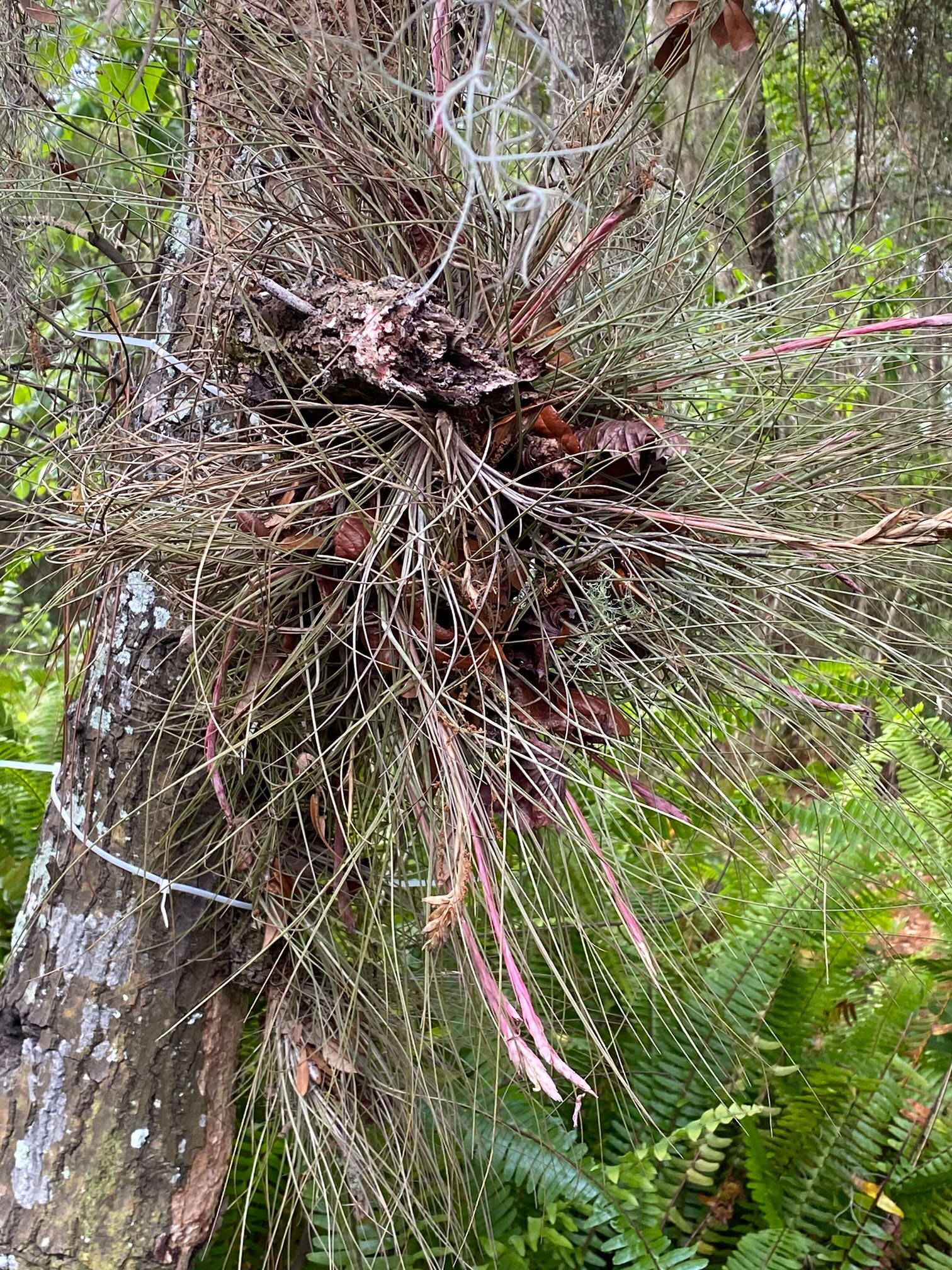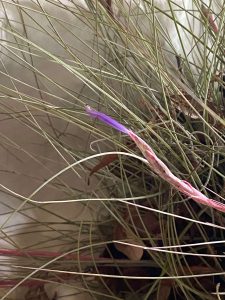The next time you are walking in a wooded area, look up… you might see a remarkable organism, a Tillandsia bartramii Elliott. Unlike a “traditional” plant, this Tillandsia (commonly known as Bartram’s air plant) lives a life free of soil. Members of the Bromeliad family, Tillandsia plants are epiphytes. Epiphyte derives from the Greek Epi (upon) and phyton (plant). Thus epiphytes are plants that live upon another plant.
Parasitic vs Epiphyte Plants
Unlike mistletoe, a parasitic plant whose roots invade a tree’s branches absorbing nutrients, epiphytes, like tillandsias, are benign as they do not harm or directly interact with the host plant. They do have roots that grow on the surface of the tree but do not penetrate through the bark. They serve mainly as fasters, tightly holding the plant to the tree. Interestingly, these roots do not absorb nutrients.
Ecologically, epiphytes are essential and diverse habitats for fungi, bacteria, myxomycetes (slime molds), insects, and small animals. They act like a mini buffet for feeding birds and other animals. They are well-adapted to well-lit and moist habitats. Commonly found in hammocks and pinelands near rivers, ponds, and lakes, air plants typically grow in areas where the humidity is relatively high. Tillandsia bartramii Elliott (Bartram’s air plant) is one of many native air plants plentiful in our northeast Florida natural landscape. Spanish moss (Tillandsia usneoides) and ball moss (Tillandsia recurvate) are also commonly seen tillandsias in Florida.
Epiphytes growing on living and dead trees are part of the Florida landscape. Florida’s native tillandsias are threatened by habitat loss and illegal collection. Collecting wild tillandsias can spread the invasive and very destructive Mexican bromeliad weevil, so it is essential to never harvest air plants from the wild. Given the role these plants play in the natural environment and the native beauty they impart, the best strategy is to leave these unique and harmless plants unmolested.
Description: Bartram’s Air Plant

Photo by Vicky K. -Putnam MGV
Bartram’s Air Plant is typical throughout Florida’s hammocks and pinelands. It can reach about 4-12 inches tall and 8-16 inches wide. As seen in the picture to the right, the leaves are thin, grey, and densely clustered. The flower stalks grow like a bromeliad reaching about 12 inches long pink or red bracts. The bracts cover and protect the tiny flowers that number less than 20. A small seed capsule is formed, and the seeds are dispersed by wind.
Rescue of Tillandsias
If you find a branch that has fallen with an air plant attached, you may want to save it. Remember, it is illegal to collect plants from a State or Federal Park without a permit. To rescue an air plant, gently remove as much of the branch as you can. Then you can mount it either on another branch or place it in a crotch of a tree. You can secure it using some liquid nails, glue, or wire. It needs to be secure enough not to wiggle in the breeze. Over time the air plant will grow new roots to secure itself to the tree. Finally, they should be put in a bright location but not in direct sunlight.

One last word. Most Tillandsias are monocarpic. Monocarpic means that these plants bloom once, and then the main (mother) plant dies. However, new plantlets start to grow from the base or the seeds inside the flower.
Air plants have gained popularity over the last few years. A light misting of water, indirect sunlight, and air circulation makes air plants a great and easy plant to keep even at home. However, environmentally speaking, Florida’s air plants are best enjoyed on a tree in nature.
Check these references for more information
Save Florida’s Bromeliads Tillandsia bartramii Bartram’s airplant
Gardening Solutions: Air Plants
Gardening Solutions: Epiphytes
FLORIDA’S NATIVE BROMELIADS – EDIS Publication (PDF)
About the Author: This Blog Article was written by Vicky K., a Master Gardener Volunteer. It was edited by Julio Perez, UF/IFAS Extension Horticulture Agent I.
 0
0
